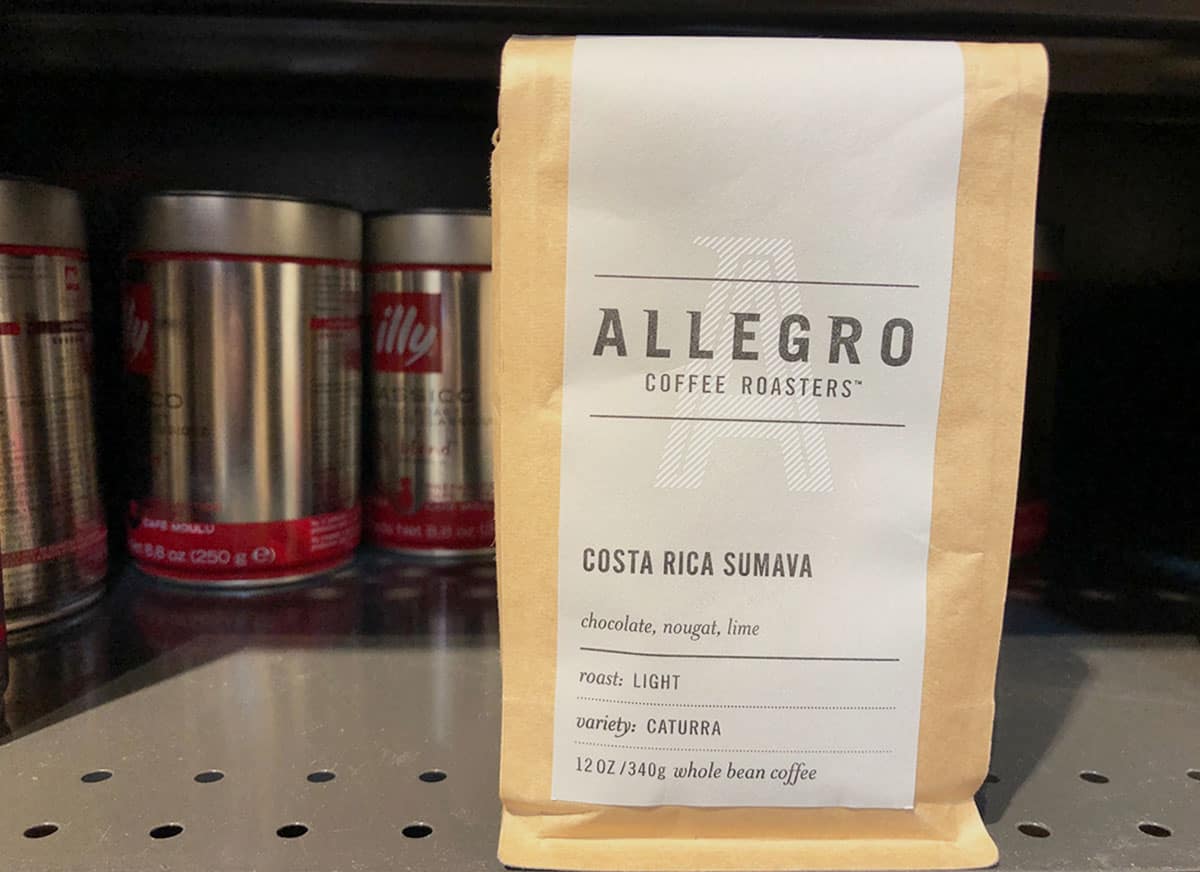Have you gone to the supermarket in Costa Rica or elsewhere or maybe even your local coffee roaster and tried to understand what all that information is on the coffee bag? Reading the label may seem confusing with all the information that is on it.
How do you read and understand a coffee bag label? Coffee bag label information includes:
- Name of the roasting company
- The origin of the coffee
- Single Origin or Blend
- Roast Level
- How the Coffee was Processed
- Coffee Variety
- Altitude
- Any Certifications
- Whole Bean or Ground
All that information written on the coffee bag label will give you pretty good picture of what we might find within. Let’s take a in-depth look at all this information.
What Information is on a Coffee Bag Label?
It’s almost impossible to tell if a coffee is going to be good without tasting it. It can pretty hard to know if the coffee will be the most delicious thing you’ve had, or a total disappointment. But you can improve your chances by being able to better understand what all that information on the label is tell you so you can make a better decision.
Keep in mind that there is currently no set regulations on what has to be on coffee bag label other then basic legal stuff such as how much each bag weighs and probably a bar code, if you are buying it from a supermarket.
Therefore, when you go to look at label it may have slight variation that what is listed here. Lets go ahead and break down each part of a common label and see what each part of it is telling you and the importance of it.
Brand Name
Usually loud and proud, at the forefront of the packaging, will be the name of the person or people who roasted the coffee. These people didn’t just roast the coffee though— they also chose the coffee to roast.
A roaster’s ability to source and choose high quality, well-produced green coffee takes as much skill, if not more, than roasting, brewing or choosing the grapes to make into a fine chardonnay.
Origin of the Coffee
More likely than not, any given bag of coffee will have the name of the country in which it’s contents were grown. Even most coffees you’ll buy from the supermarket, specialty or not, will proudly claim their Brazillian or Costa Rica heritage.
While knowing the country of origin doesn’t tell us if a coffee will be good or not, it does give us some idea of what we can hope for. For example, I can be pretty sure that if I have a bag of coffee from Kenya, it might be fruity and have strong berry notes (Kenyan coffees are often described as a berry-bomb)— whereas if I have a coffee from Ethiopia, there is a high chance it will be light, with floral and citrus notes in the cup.
Of course, bringing out these delightful flavors in a coffee largely depends on how well the roaster does their job of roasting it.
Most good coffee roasters go a step further by offering the localized region a coffee was grown (and sometimes even the specific farm).
Name of the Farm
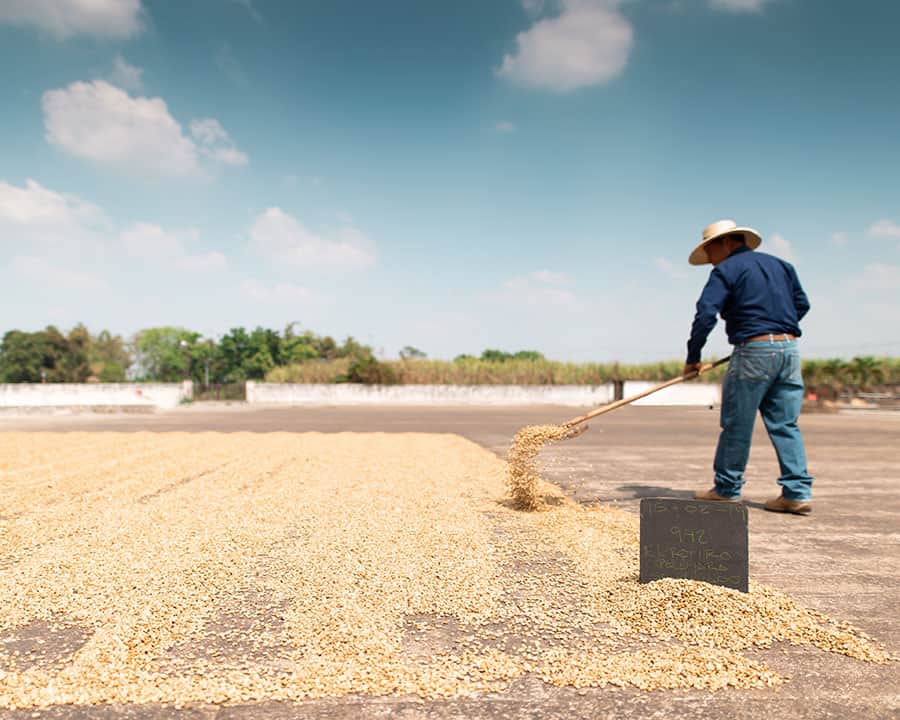
Many coffee roasters who source their coffee directly, will include the name of the particular farm from which it came, on the bag. As a result of this, and because they produce ridiculously good coffees, farms like Finca Kilimanjaro or La Palma y El Tucan have become quite famous.
A single coffee farm can often grow many different coffee varieties at varying altitudes.
Including the name of the farm, while not directly indicating delicious coffee, does indicate traceability (which very often translates to something tasty).
Is the Coffee a Single Origin or Blend?
The term single origin is used in the coffee industry to describe coffee that is all grown in the same place. In terms of specialty coffee, this is usually one single farm or coffee producer.
The term does vary quite a lot though. In some cases, single origin will refer to a small growing region consisting of a few farms which share a processing station, and, in the case of non-specialty grade coffee, single origin can refer simply to coffee that was all grown in the same country.
Single Origin Coffee
Single origin coffees generally offer the drinker a flavor profile that is very specific. The tasting notes written on a bag of coffee from the Sidama region of Ethiopia could consist of earl grey tea and lemon— or strawberry and chocolate written on a bag of coffee from the Huye region of Rwanda.
Single origin coffees are usually consumed black, as to allow their unique flavor characteristics to shine through.
Coffee Blends
Blends, on the other hand, are a mix of beans, often from different countries. The coffee roaster is the one who decides on what coffees go into a specific blend, and in what percentages.
With a blend, a coffee roaster can essentially design a flavor profile— for example, taking the fruitiness of a Kenyan coffee, and blending that with the cocoa notes given by a Colombian coffee.
Blends are generally designed with milk coffee in mind, for lattes and cappuccinos, but some roasters do some fantastic filter coffee blends.
What is the Coffee Roast Level?
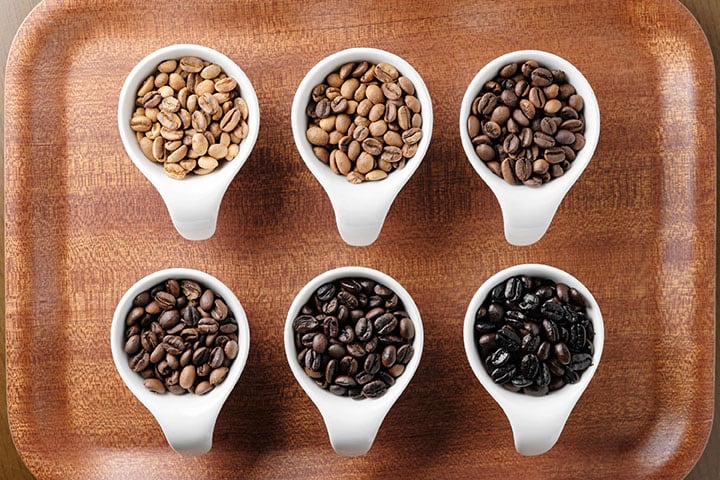
Roast level, or roast degree, will refer to how dark a coffee is roasted. Coffee arrives at the coffee roaster as a green seed. The seed is roasted in a specially made in a coffee roaster until the roast masters desired roast level is achieved. The lighter a coffee is roasted, the less time it has spent in the roaster.
Roasting coffee works in a similar way as roasting a vegetable— the longer they spend in the oven, the darker and more roasted they get. Now, in the case of carrots and potatoes and the like, getting those delicious roasty flavors, the sticky caramelized edges— this is what we want. But with a really good, well-processed coffee, those flavors that work so well on root vegetables, are not so desirable in coffee.
You’ll find most quality coffee shops will be roasting their coffee on the lighter end of the scale, somewhere from light, which is the standard in Scandinavian countries, to medium roast, as is the norm in Australia. Medium to a medium dark roast levels are generally the darkest a good coffee roaster using quality green coffee, will go.
A light roasted coffee will give the most honest representation of the coffee. With little roast flavors present, all you’ll taste is the bean itself. When a coffee is roasted too light though, there can be distinct notes of grass and hay in the cup.
A medium roasted coffee will be a happy medium, balancing the delicate ‘true’ flavors of the coffee, with pleasant, sweet flavors brought on by the roast.
A dark roasted coffee will be visually dark, and often oily. Little to none of the original coffee flavors will be present in the cup, having been overpowered by a strong ‘roast’ flavor.
In the cup, there will be, on the pleasant end, notes of chocolate and caramel, and on the unpleasant end; bitter, rubber, meaty and ashy.
How was the Coffee Processed?
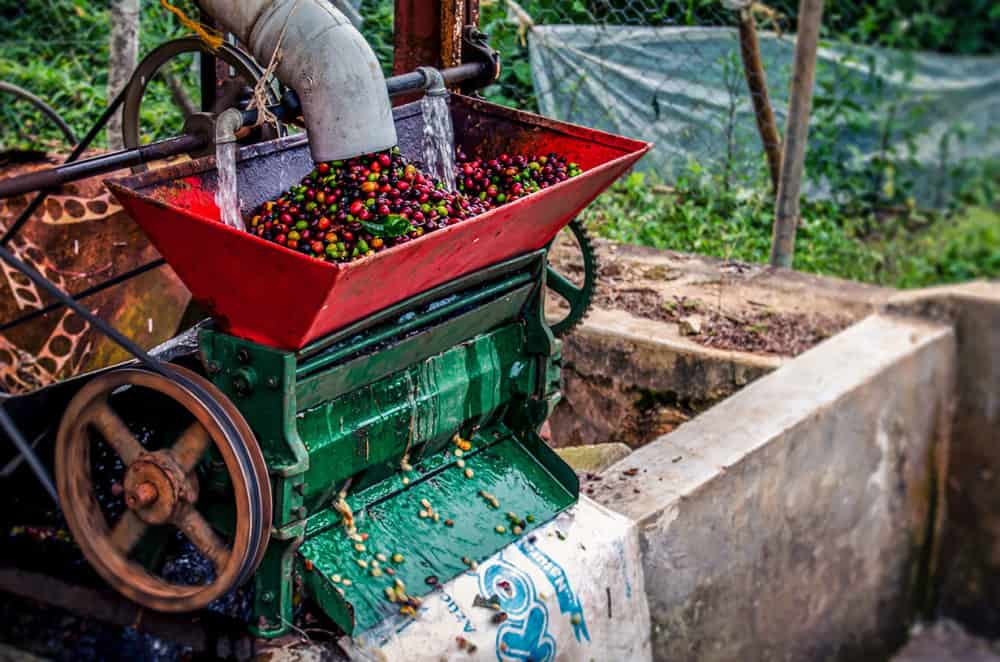
After a coffee cherry is plucked from the tree, and sorted, the coffee will undergo a certain form of processing. The way a coffee is processed will have a huge impact on the way it will taste.
There are three main ways of processing coffees; washed, natural and honey. Each of these processing methods is an entire article (or book!) in itself, so we’ll touch on each briefly.
Note that these are not the only three processing methods. There are many more, some of which involve the coffee being fermented in oxygen-free or carbon dioxide-rich environments, called anaerobic and carbonic maceration, respectively. The three mentioned here are by far the most common.
Washed Processing Method
After picking and sorting, the coffee is transferred to a machine that will separate the fruit from the seeds within. Once the seeds have been extracted, they will be covered in a sticky substance known as mucilage. To remove this, the seeds are transferred to a tank of water, where they will spend between one and three days, slightly fermenting.
The bacteria produced during this process will cause the mucilage to dissolve. The coffee is then rinsed and dried to around eleven percent moisture, on either concrete patios, or raised drying beds.
In contrast to natural and honey processed coffees, washed coffees have a clean flavor profile because they have very little outside influence affecting the way they taste. This allows the flavors of the variety and the origin shine.
Natural Processing Method
The coffee is picked and sorted, then the whole seed, cherry and all, are transferred to a drying area; either patios or drying beds, where they will be left to dry for around 30 days. During this drying period, the coffee must be turned regularly to ensure even drying.
Because the seed is dried while encased in the cherry, the fruit imparts some of its sugar content and flavors onto the seed. This often gives naturally processed coffees a flavor profile of tropical fruits; pineapple, jackfruit and sometimes strawberries, with a heavy body.
They can also, as a result of over-fermentation, have a ‘boozy’ red wine characteristic to them, which some love and some hate.
The natural processing method was developed in Ethiopia, and is common in coffee-producing areas worldwide, including Costa Rica, where water is harder to come by.
Honey (Pulped Natural) Method
The honey processing method, developed in Costa Rica, is a sort of midpoint between a washed and a naturally processed coffee.
First, the coffee is picked, then sorted. It is then transferred to a machine where the producer can decide how much of the fruit and mucilage (the sticky honey-like substance around the seed) is removed.
There are generally three different levels of the honey processing method, and the amount of mucilage left on the seed will determine the amount of honey-ness the coffee will be.&
Black honey is the highest level; most of the mucilage is left on the seed. Red is in the middle, where around 50% mucilage is removed, and yellow is at the bottom, where almost all of the mucilage is removed, making yellow honey the closest to a washed coffee.
Honey processed coffees are often incredibly sweet. They tend to have brown sugar and dried fruit qualities to them, and luckily, rarely have the ‘boozy’ defect present in some natural coffees.
What is The Type of Coffee Bean?
There are two main species of coffee trees that we, as humans, grow and use and make into a delicious magical beverage; Arabica, and Robusta. It is essentially a prerequisite that, within specialty coffee, all the coffee offerings will be Arabica.
Branching off of the Arabica variety, there are hundreds of sub-varieties. Many of these varieties share genetic heritage, with only slight mutations, like size for example, causing them to grow more effectively in their climate.
Possibly the most famous of all coffee varieties is Gesha; the highly prized (and incredibly expensive) seed that has captured the hearts of all who have had the pleasure of trying it.
Some other popular and incredibly delicious varieties of coffee are Red Bourbon, SL-28, Pacas, Rume Sudan, and Caturra.
While knowing what variety of coffee you have may not be insightful to begin with, it does eventually, once you have consumed enough coffee and taken enough notes about the varieties you are enjoying, become a deciding factor as to what you’ll choose next.
At what altitude what the Coffee Grown?
The altitude at which a coffee plant is grown can say a lot about how sweet, and how complex a coffee might be. Most great coffee-producing regions, like Costa Rica, are high altitude, sitting somewhere between 1000 and 2000 meters above sea level. This high altitude rule is almost a prerequisite, with very little (if any) of the world’s high scoring coffee coming from low lying regions.
There are dozens of factors as to why higher altitudes produce better and more intricate coffees. One such reason, is that the higher the altitude at which a coffee is grown, the less oxygen is available. This means the cherries mature more slowly, developing more complex sugars within.
What are the Flavor Notes of the Coffee?
Coffee roasters, after they have finished roasting, will perform a tasting procedure known as cupping. Basically, they’ll grind up their coffee, put them in small bowls side by side, and smell them.
Then, hot water is added, the crust is broken and the grind is skimmed from the top of the bowl using spoons. The coffee is then tasted (loudly slurped is more accurate!). The flavor profile written on a bag of coffee, is the notes from this cupping session.
A flavor profile, rather than being an exact description as to what you’ll taste: you will feel like you are eating a chocolate bar or a mango— is more of a: this coffee reminds us of chocolate or has the acidity and sweetness of a juicy mango.
That’s not to say that some coffees don’t, with every sip, taste of a mouthful of blueberries, as with some Kenyan SL-28 variety coffees.
The flavor profile written on a bag of coffee is very much like the tasting notes on a bottle of wine; it is very personal and subjective to the taste buds of whoever wrote it, but will give you a ballpark idea of what to expect.
What are the Coffee Certifications?
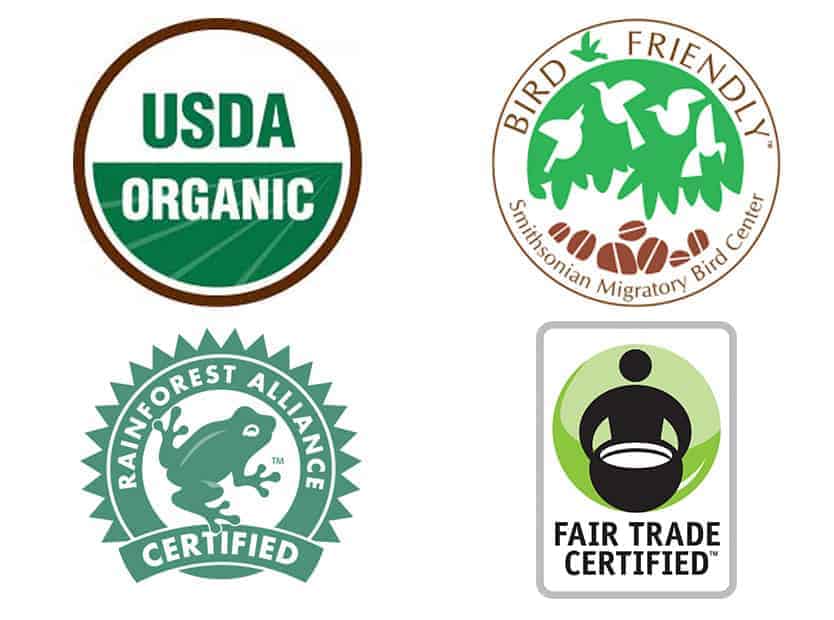
A sack of imported green coffee can carry many different coffee certifications. These certifications are often displayed on roasted coffee packaging in the form of a small tag or tags.
This means that the coffee producer, or the green coffee buyer, has met the criteria set by a particular foundation— whether that be the Rainforest Alliance, Fairtrade America or the Smithsonian Migratory Bird Center.
The absence of one of these tags by no means implies that the farmers are treated poorly, or the farm is practicing ecologically damaging farming techniques. Many coffee roasters directly source their coffee, working closely with producers and their farms, and pay them well above fairtrade prices for their coffees.
When was the Coffee Roasted?
This is the date the coffee was roasted. It is important to know when the coffee is roasted, not only so we can tell when the coffee is past it’s prime, but also when the coffee is ready to be used. You’d never know just by looking at a coffee, how old it is. Short of brewing it, the roast date is the only way to tell it’s age.
During the roasting process, multiple chemical reactions occur within the coffee bean, and as a result, carbon dioxide gas builds up inside the bean. Over the next five days or so, the roasted coffee is rapidly giving up its stored C02 in a period that is known as de-gassing.
Any coffee brewed during this time may brew unevenly due to the release of gas, resulting in sharp, bitter or overly acidic flavors in the cup.
For best results, use your coffee between five and 15 days ideally or up thirty days after the roast date printed in the bag.
A good coffee roaster is keen to tell you what they know about their coffee. And you might notice that the more dedicated to their craft a coffee shop or roaster is, the more information they will have about the coffee.
If a coffee roaster knows the name of the person who grows the coffee, or the names of their entire family, you better know they’ll be putting that on the bag.
Is the Coffee Whole Bean or Ground
On every bag you look at, you will notice it will say either ground or whole bean. I would highly recommend that buy whole bean coffee and grind it only as you make your coffee. The reason for this is because once you grind coffee it will immediately start to lose it flavor qualities.
Therefore by the time you go to brew your coffee, most of the taste that you are looking for will be gone. It is for this reason that many specialty roasters will only sell whole bean coffee.
If you don’t have a grinder, you will want to get a burr grinder as it chops up the beans more evenly for a better tasting coffee.
Final Thoughts
While many of the things we see on a bag of coffee have little practical use for us; knowing the name of the farm, for example, is one such thing that doesn’t mean a whole lot and won’t give us any indicators of the flavors in the bag (unless we’ve had coffee from this farm before), what that level of information does tell us though, is that the roaster actually knows this information.
This level of information means traceability. And traceability in coffee is a really good thing. We know exactly what we are getting, we know the people who we are getting it from, and we know from exactly where we are getting it. The more information, the better.

